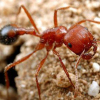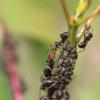introduce tough native species to infested areas. for example, you could transplant solenopsis xyloni or geminata, which are both aggressive natives that can defend against argentines. A better option, however, would be to collect and transplant a colony of a brood raider such as neivamyrmex, which could decimate invasive nests, especially myrmicines like megacephala or invicta.
The Neivamyrmex would almost certainly die due to being outside of their established territory.
A great example of this happening is in my region of South Carolina. A paper published in 2009 by Timothy Davis from Clemson lists the counties specific ants were found in in the state. I'm in Richland, and the paper lists both Neivamyrmex nigrescens and opacithorax as being collected from this area, along with a few other rare species such as Aphaenogaster mariae. However, this paper was published back when Brachyponera chinensis was considered a low threat species that Myrmecologists assumed would either be confined to small, isolated populations or be wiped out altogether be some of the stronger invaders and natives. However, due to the fact that Brachyponera become active very early in the anting season, they are able to wipe out native species before colonies are fully active and ready to fight back, leading to Brachyponera chinensis' eventual spread from northern South Carolina to all over the southeast wherever termites are present. They have been able to force out many native ant species (especially forest dwellers like Camponotus and Lasius) and have become the dominant species in some areas. While Neivamyrmex are strong, there are some species not even they can take out. Brachyponera are able to force out or even downright decimate Neivamyrmex bivouacs before they become active during the spring. Combining this with the fact that Linepithema humile are exploding in population in the southeast, as Neivamyrmex do not stand a chance, and are forced to areas where the species are less prevalent. Also, Neivamyrmex do not found like other ant species. As opposed to true queens, Dorylines have heavily modified workers known as Dichthadiigynes, more commonly known as ergatoid queens (more accurately referred to as ergatoid gynes, as they are not true queens). Colonies only produce a few Dichthadiigynes a year, and as such, the species is very slow to spread. Colonies produce more males, but even those are rarely seen in colonies, and only a handful are produced every year. Neivamyrmex would not be very good at eradicating exotics, despite their aggressive and ravenous nature. Plus, it is never a good idea (except in VERY rare instances as a last resort) to introduce a new species to an area to combat an invader, especially not something as ravenous as a Doryline. There's a reason why other ants fear them, evacuating their nests as quickly as possible when Dorylines are nearby. I mean, say the purposefully introduced species eradicates the target species, a very unlikely scenario. Then what? It's simple, they would move on to target other native species. Say Eciton or Dorylus was introduced to California to eradicate Linepithema, and say the miraculously they manage to win. The Dorylines wouldn't just give up and die, they would continue on to attack other species, eventually becoming the new, potentially worse, Linepithema. Introducing a new species to deal with the invaders should only be used as a last resort and only if the targeted species is the only thing the invader will touch, such as is the case with the introduction of Pseudacteon flies into the southeastern US to deal with Solenopsis invicta. So yeah, introducing Neivamyrmex would not be an effective way to deal with invaders.























